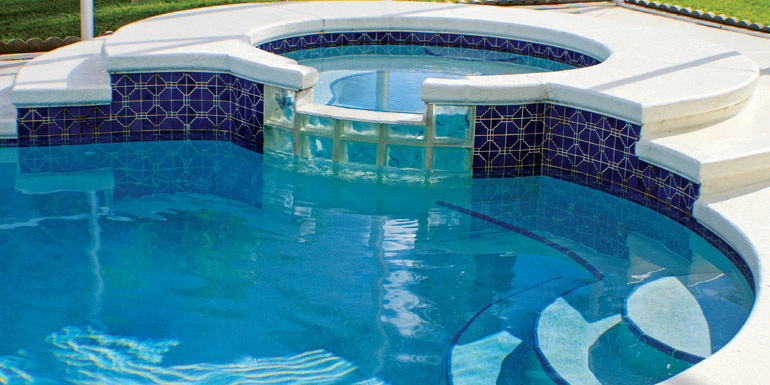Ontario’s electrical safety code guidelines for pool/spa installations
by Sally Bouorm | December 1, 2013 3:41 pm
 [1]
[1]By Tatjana Dinic
The Ontario Electrical Safety Code (OESC) provides the minimum safety requirements for electrical installations in various locations. Section 68 of the OESC includes rules specific to electrical installations and electrical equipment related to swimming pools and spas/hot tubs. Grounding and bonding rules in the code are always challenging, and Rule 68-058, which provides bonding requirements for pools, is no exception.
This article will illustrate the OESC’s 25th edition/2012 bonding requirements[2] and provide clarification about ground fault circuit interrupters (GFCIs) as they pertain to swimming pools and spas/hot tubs. Several frequently asked questions by pool installers and electricians are also addressed.
Bonding requirements for pools and equipment
Metal parts of the swimming pool and other associated non-electrical equipment (e.g. piping, pool reinforcing steel, ladders, diving board supports, fences, etc.) are required to be bonded and connected to non-current-carrying metal parts of electrical equipment associated with the pool and/or spa/hot tub (e.g. circulating pump) as per figures 1, 2, and 3. Parts of non-electrical and electrical equipment can be bonded to each other, or to a pool, in series or parallel connections.
The bonding required above, as per Rule 68-058 (1), is done to eliminate voltage gradients in the swimming pool and spa/hot tub areas and to ensure all metallic parts described in the rule are at the same electrical potential. Therefore, if it is not specifically asked by equipment manufacturers, pool bonding conductor specified by Rule 68-058 (1) is not required to be connected to a grounding electrode.
Rule 68-058 (4) requires a minimum size of bonding conductors for pools to be no smaller than No. 6 American wire gauge (AWG) copper. For all other pools, where the bonding conductor is incorporated within a cable assembly or raceway, the bonding conductor is sized according to Table 16 of the OESC.
Bonding requirements specified in Rule 68-058 are applicable to different types of swimming pool structures with conductive pool shells such as:
i. pools with a metal shell;
ii. pools with poured or concrete blocks with structural reinforcing steel; or
iii. pools with encapsulated reinforcing steel.
I. Bonding requirements for pools with a metal shell
 [3]
[3]A galvanized steel pool shell comprising individual panels securely bolted together must be bonded to the pool equipment in at least one location. (See figure 1.) Because parts of non-electrical and electrical equipment are allowed to be bonded to each other, or to a pool in series or parallel connections, all parts may be connected in series to each other and then to the steel pool structure at one location.
If there is a break in the outer metal shell by a non-conductive material (i.e. fibreglass stairs), then a jumper is required across the break (or bond each section individually). Bonding jumpers must be the same size as the bonding conductor, e.g. no smaller than No. 6 AWG copper.
II. Bonding requirements for pools with reinforcing steel
 [4]
[4]Rule 68-058 (2) requires a pool’s reinforcing steel to be bonded with a minimum of four connections equally spaced around the perimeter, as well as to the pool equipment. (See figure 2.)
iii. Bonding requirements for pools with encapsulated reinforcing steel
 [5]
[5]A bonding grid around a swimming pool cannot be formed when the reinforcing steel is encapsulated with a non-conductive compound. Therefore, Rule 68-058 (3) and Appendix B requires a bonding loop (no smaller than No. 6 AWG copper) around the pool if the steel is encapsulated. (See figure 3.) Pool equipment must be bonded to this loop.
Bonding for non-conductive pool structures
The OESC does not have bonding requirements for swimming pools with non-conductive materials such as fibreglass, composite, or resin. If other conductive non-electrical equipment associated with the pool is installed (e.g. ladders or fences) it would need to be bonded to the swimming pool’s electrical equipment.
The following questions are often asked about swimming pool electrical equipment with respect to bonding requirements as per Rule 68-058:
Q. Where a panel board feeds swimming pool electrical equipment that is bonded to conductive non-electrical equipment associated with the swimming pool in compliance with Rule 68-058, is an additional No. 6 bonding conductor required between the panel board and the pool’s electrical equipment?
A. No. The OESC does not define what is meant by ‘pool electrical equipment.’ To facilitate consistent application of the rule by all OESC users, the following direction has been developed:
Swimming pool electrical equipment includes anything associated with the circulation system (e.g. pump motors, pool water heaters, etc.), as well as automatic pool cover operation (e.g. electric motors).
Q. Does the installation of new swimming pool equipment, or the replacement of existing equipment (e.g. the installation of a heater where there was no heater before, or pump replacement) on an existing pool built prior to 2009, where no pool bonding was previously installed, require pool and equipment bonding be brought into compliance with Rule 68-058 (1) of either the 2009 or 2012 edition of the OESC?
A. No, provided the new or replaced equipment is not located within 3 m (9.8 ft) of the swimming pool’s inside wall, or is suitably separated from the pool by a fence, wall, or other permanent barrier.
Requirements for GFCI protection
Rule 68-068 requires electrical equipment located within the confines of the pool walls or within 3 m (9.8 ft) of the pool’s inside walls to be protected by a ‘Class A’ GFCI unless the electrical equipment is suitably separated from the pool area by a fence, wall, or other permanent barrier.
Therefore, for a cord-connected pool pump, based on the receptacle type and location, the following are code requirements for GFCI protection:
- If the pump is cord connected to an outdoor residential receptacle of 5-15R or 5-20R configuration, Rule 26-710 (n) requires the receptacles to be protected by a Class A GFCI. In this case, it does not matter if the pump is located further than 3 m (9.8 ft).
- If the pump is cord connected to a receptacle other than a 5-15R or 5-20R configuration, and the pool pump is within 3 m (9.8 ft) of the pool, the code requires Class A GFCI protection for the branch circuit supplying this receptacle.
- If the pump is cord connected to a receptacle other than a 5-15R or 5-20R configuration, and the pool pump is not within 3 m (9.8 ft) of the pool, GFCI protection is not required by the code.
 [6]
[6]It is important to note, Rule 68-064 does not permit a receptacle to be located closer than 1.5 m (5 ft) to the swimming pool. Further, in the 2012 edition of the OESC, Rule 26-702 requires receptacles of 5-15R, 5-20R, 5-20RA, 6-15R, 6-20R, and 6-20RA configurations that are exposed to weather be provided with cover plates suitable for wet locations, whether or not a plug is inserted into the receptacle. These cover plates are commercially known as ‘in-use covers’ or ‘Raintight While-In-Use [7]covers.’
Electrical equipment such as saltwater chlorinators and control panels are not required to be protected by GFCI if they are located further than 3 m (9.8 ft) from the swimming pool (or spa/hot tub), or behind a suitable barrier as per Rule 68-068, unless required by the electrical equipment manufacturer. It is important to note, the recently amended Canadian Standards Association (CSA) standard C22.2 No. 218.1, Spas, Hot tubs, and Associated Equipment, now includes certification requirements for electrolytic chlorine and bromine generators and does not provide requirements for GFCI protection for chlorinators. Although it is not mandated in Section 68 for all installations, and the standard referenced above for chlorinators, many manufacturers of associated pool equipment require Class A GFCI protection of their products as per nameplate or installation instructions.
When a heater or pool pump is located more than 3 m (9.8 ft) away, or is isolated by a suitable barrier supplying a spa/hot tub that shares common water circulation with a pool, the OESC does not require GFCI protection unless it is required by the manufacturer. Although Rule 68-070 (7) requires spas/hot tubs to be protected by a GFCI, the spa/hot tub is part of the swimming pool and, therefore, is inspected as part of the pool.
Q. Does the OESC permit the installation of extra-low voltage landscape lighting systems within 3 m (9.8 ft) of swimming pool or spa/hot tub?
A. Yes, provided the power supply is GFCI protected as required by Rule 68-068 and does not bear the marking “Do not mount power supply or luminaires within 3 m (9.8 ft) of a swimming pool or spa” (Rule 2-034). Further, CSA standard C22.2 No. 250.7-07, Extra-low-voltage landscape lighting systems, Clause 6.101.3 power supply marking and instructions, states, “A power supply shall be marked in accordance with Table 20.101.1 and shall be provided with installation instructions in accordance with Table 20.102.1, Items 2.1 to 2.11, as applicable.” Item 2.8 in Table 20.102.1 states, “Do not mount power supply or luminaires within 3 m (9.8 ft) of a swimming pool or spa.”
For more information, see the ESA Bulletin 68-7-*. This bulletin is updated frequently as additional questions are asked or the code requirements are changed. For more information about ESA Bulletins and how to purchase them, visit http://www.orderline.com/detail.asp?group=23613[8].
 Tatjana Dinic, P.Eng., is a code engineer with the Electrical Safety Authority (ESA) in Ontario, which establishes safety standards for the installation of electrical equipment in the province and is in charge of enforcing the Ontario Electrical Safety Code (OESC). She can be reached via e-mail at tatjana.dinic@electricalsafety.on.ca[9].
Tatjana Dinic, P.Eng., is a code engineer with the Electrical Safety Authority (ESA) in Ontario, which establishes safety standards for the installation of electrical equipment in the province and is in charge of enforcing the Ontario Electrical Safety Code (OESC). She can be reached via e-mail at tatjana.dinic@electricalsafety.on.ca[9].
- [Image]: http://poolspamarketing.com/wp-content/uploads/2013/12/dreamstime_l_6627538_edited-1.jpg
- bonding requirements: http://www.esasafe.com/about-esa/governance-and-regs/electrical-safety-code
- [Image]: http://www.poolspas.ca/wp-content/uploads/2015/05/Diagram-1.jpg
- [Image]: http://www.poolspas.ca/wp-content/uploads/2015/05/Diagram-2.jpg
- [Image]: http://www.poolspas.ca/wp-content/uploads/2015/05/Diagram-3.jpg
- [Image]: http://www.poolspas.ca/wp-content/uploads/2015/05/In-Use-Cover.jpg
- Raintight While-In-Use : http://www.orderline.com/detail.asp?group=23613
- http://www.orderline.com/detail.asp?group=23613: http://www.orderline.com/detail.asp?group=23613
- tatjana.dinic@electricalsafety.on.ca: mailto:tatjana.dinic@electricalsafety.on.ca
Source URL: https://www.poolspamarketing.com/trade/ontarios-electrical-safety-code-guidelines-for-poolspa-installations/

